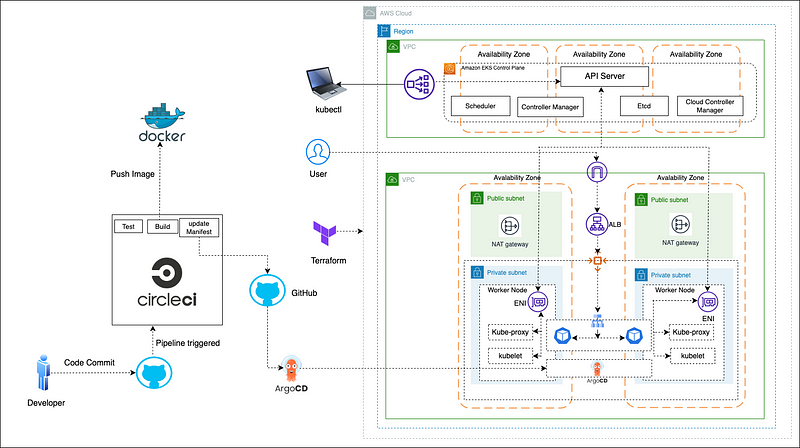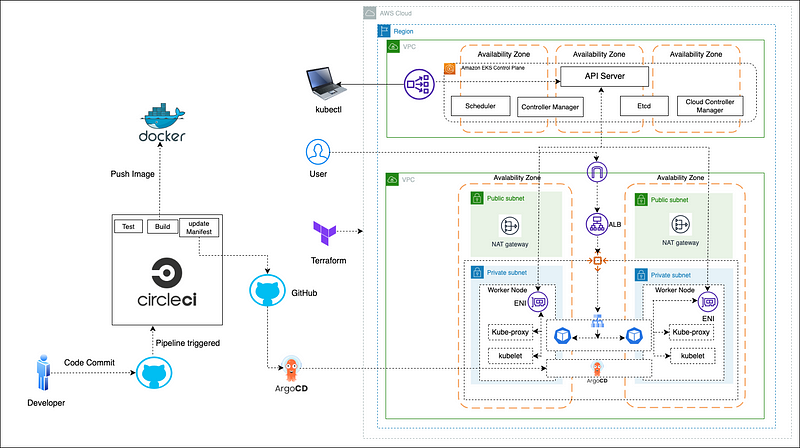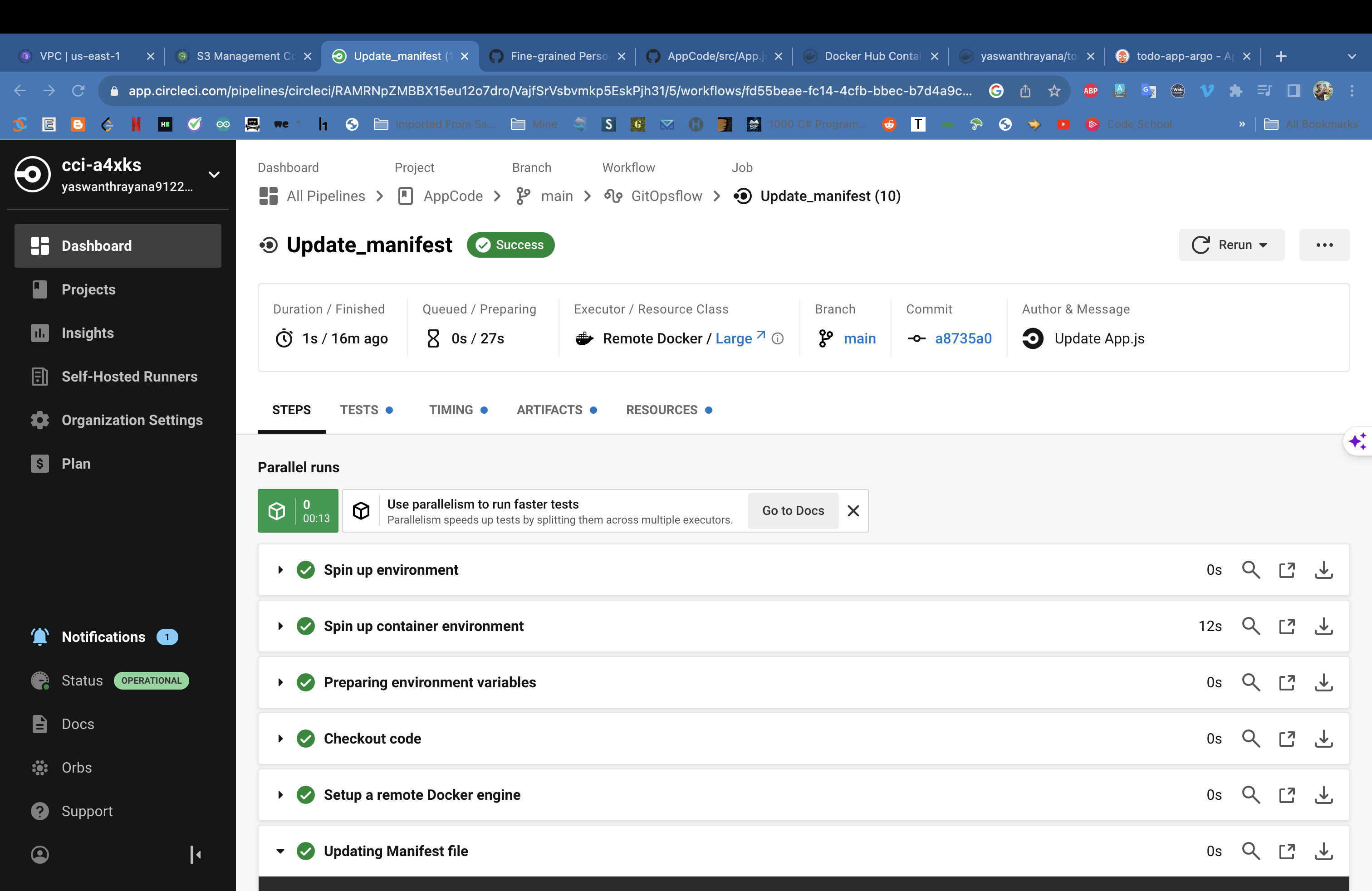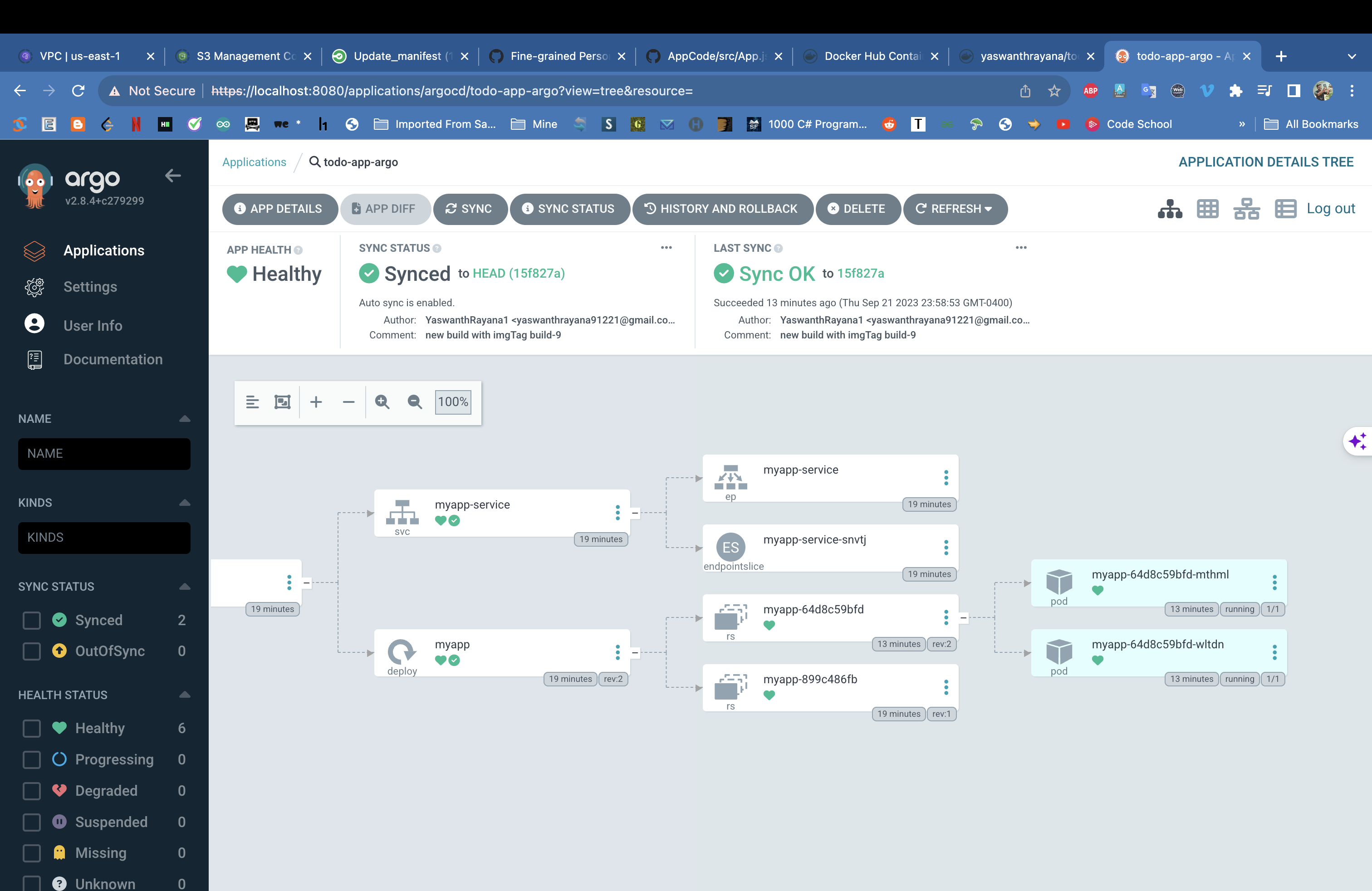Deploying an application using Docker, EKS and Argo CD
 Yaswanth Kumar Rayana
Yaswanth Kumar RayanaTable of contents

Hello everyone, Hope you are doing well. Today I'm implementing a project which is a part of 10WeeksofCloudOps, project 4. In this project, we are going to deploy an application based on the concept of GitOps, in our case GitHub is considered as the single source of truth.
A huge shout out to The CloudOps Community and Piyush Sachdeva, who has implemented this project on his YouTube channel. Here is the diagram that shows us how the project has been implemented

First of all, we will configure the AWS CLI for our visual studio code following this guide:
https://docs.aws.amazon.com/toolkit-for-vscode/latest/userguide/welcome.html
Configure the AWS CLI for the root user using the
aws configure command, in the blog we are going to use the following resources using the following custom terraform modules.
EKS
NatGateway
IAM
Node Group
VPC
As a part of the project first create an S3 bucket and a Dynamo DB table to store the tfstate file of our project. Make sure the Public access to the S3 bucket has been blocked, and enable the bucket versioning.
Create a DynamoDB table and make sure the partition key is set to LockID String type.
Here is the source code for application in the git repository:
https://github.com/YaswanthRayana1/AppCode
To deploy the application on an EKS cluster we need the infrastructure, clone the git repository locally and make necessary changes to the backend.tf file
https://github.com/YaswanthRayana1/10weeksofcloudops-demo4-tf
Kube manifest git repo
https://github.com/YaswanthRayana1/kube_manifest
Clone both repositories, remove the Git remote for the application code folders and add your Git remote by following this guide
https://stackoverflow.com/a/44076938/22772068 and upload the code to your git repository.
To start first, change the
cd 10weeksofcloudops-demo4-tf/ToDo-App/
Use any of the code editors
Change the Bucket name to the S3 bucket you created in AWS S3.
terraform {
backend "s3" {
bucket = "week4"
key = "backend/ToDo-App.tfstate"
region = "us-east-1"
dynamodb_table = "week4"
}
}
- We also need to create a
terraform.tfvarsfile that contains the variables like public and private subnet CIDRs
REGION = "us-east-1"
PROJECT_NAME = "ToDo-App"
VPC_CIDR = "10.0.0.0/16"
PUB_SUB1_CIDR = "10.0.1.0/24"
PUB_SUB2_CIDR = "10.0.2.0/24"
PRI_SUB3_CIDR = "10.0.3.0/24"
PRI_SUB4_CIDR = "10.0.4.0/24"
Since we already have the terraform modules for all the resources we are creating on the AWS, we can create them as follows:
terraform init will initialize the terraform dependencies in the 10weeksofcloudops-demo4-tf folder
Once dependencies have been initialized, use the
terraform plan to check the resources that are going to be created,
terraform apply and use this command to create the infrastructure.
Once the infrastructure has been created, verify the resources in the AWS console.
aws eks update-kubeconfig --region us-east-1 --name ToDo-App
Use this command to add the kube config file of the EKS cluster we created to our kube context, so now all the kubectl commands we use will point to the cluster we have created using the terraform apply.
- In this project we are using Circle CI for Continuous Integration and Argo CD for Continuous Delivery. Use GitHub to sign up for CircleCI.
Continuous Integration
In the app code repository create a folder .cicleci/config.yml and use the following code to build, push and update the manifest of the deployment.yml file.
version: 2.1
jobs:
build_and_push:
docker:
- image: cimg/node:20.3.1
steps:
- checkout
- setup_remote_docker
- run:
name: Lets build and push image
command: |
version="build-$CIRCLE_BUILD_NUM"
echo $version
docker build -t yaswanthrayana/todo-app:$version .
echo $DOCKER_PASSWORD | docker login -u $DOCKER_USERNAME --password-stdin
docker push yaswanthrayana/todo-app:$version
Update_manifest:
docker:
- image: cimg/base:2023.06
steps:
- checkout
- setup_remote_docker
- run:
name: Updating Manifest file
command: |
TAG=$CIRCLE_BUILD_NUM
((TAG--))
git clone https://github.com/YaswanthRayana1/kube_manifest.git
git config --global user.email "yaswanthrayana91221@gmail.com"
git config --global user.name "YaswanthRayana1"
pwd
cd kube_manifest
pwd
echo $TAG
sed -i "s/build-.*/build-$TAG/g" manifest/deployment.yaml
cat manifest/deployment.yaml
git add .
git commit -m "new build with imgTag build-$TAG"
git config credential.helper 'cache --timeout=120'
git push -q https://$GITHUB_PERSONAL_TOKEN@github.com/YaswanthRayana1/kube_manifest.git main
workflows:
GitOpsflow:
jobs:
- build_and_push
- Update_manifest:
requires:
- build_and_push
Make necessary changes to the above file such as the GitHub username, Docker hub username, Email id etc.,
Create a personal access token in GitHub to use in the CircleCI to trigger the pipeline in the CircleCI
https://github.com/settings/tokens?type=betaCreate a Fine-grained token and give admin access to the git repository that contains the Application code along with the
.cicleci/config.ymland save it to configure the CircleCI project settings.Once the pipeline is configured, CircleCI should build a docker image and push it to the DockerHub.

Continuous Deployment
Run the following commands to install ArgoCD
kubectl create namespace argocd
kubectl apply -n argocd -f https://raw.githubusercontent.com/argoproj/argo-cd/v2.4.7/manifests/install.yaml
This deploys the ArgoCD application controller and other required objects in the argocd namespace and to manage the application.
We need to port forward the ArgoCD server to access the GUI,
kubectl port-forward svc/argocd-server 8080:443 -n argocd
Open a new terminal to get the ArgoCD secret, get the ArgoCd secret on the argocd namespace.
kubectl get secrets -n=argocd this gives us the secrets that have been deployed in the argocd namespace.
The initial admin secret is in base64 encoded to get the secret
kubectl get secret argocd-initial-admin-secret -n argocd -o yaml
Copy the base 64 encoded password and decode the secret using the echo command:
echo <base-64-encoded-password> | base64 --decode
Use the password to log into the ArgoCD dashboard.
Create a argo-manifest.yml file that contains the GitHub URL for the Deployment and Service files, ArgoCD pulls the new docker image and deploys it in the destination myapp namespace.
apiVersion: argoproj.io/v1alpha1
kind: Application
metadata:
name: todo-app-argo
namespace: argocd
spec:
project: default
source:
repoURL: https://github.com/YaswanthRayana1/kube_manifest
targetRevision: HEAD
path: manifest
destination:
server: https://kubernetes.default.svc
namespace: myapp
syncPolicy:
syncOptions:
- CreateNamespace=true
automated:
selfHeal: true
prune: true
Update the GitHub URL for the repoURL in the manifest file and apply the manifest file
kubectl apply-f argo-manifest.yml
This should pull the configuration from our git repository and apply the changes to the Kubernetes myapp namespace.
So Here comes the end of this blog,
Every time there is a change in the appcode Git repository the CircleCI pulls the code and builds the docker image, pushes it to the DockerHub and updates the build number on the deployment.yml Since our ArgoCD is watching the kube_manifest git repository, ArgoCD pulls the changes and applies them to the myapp namespace.

Thank you for following along with this guide creating a CICD pipeline using CircleCI and deploying the application on an EKS cluster using ArgoCD to manage the Continuous Deployment. Hope this blog helps, for any questions feel free to comment. I will try to resolve the errors.
Subscribe to my newsletter
Read articles from Yaswanth Kumar Rayana directly inside your inbox. Subscribe to the newsletter, and don't miss out.
Written by
